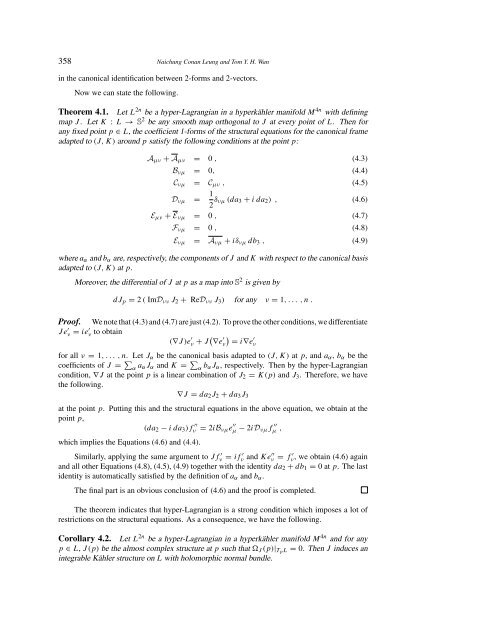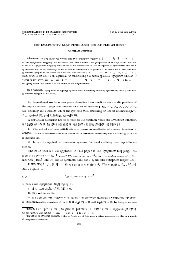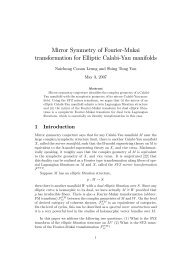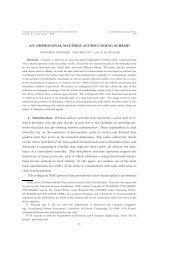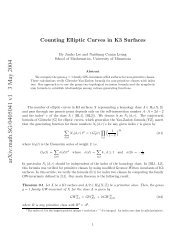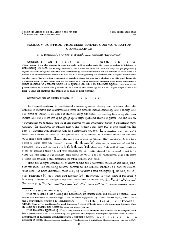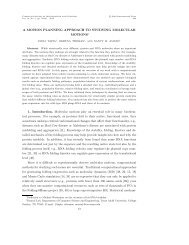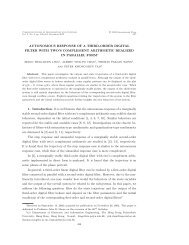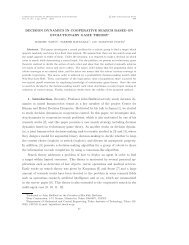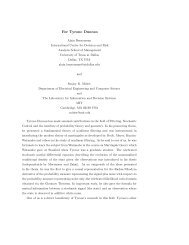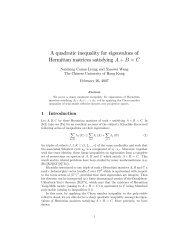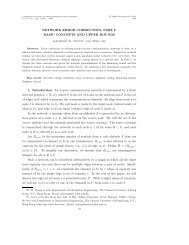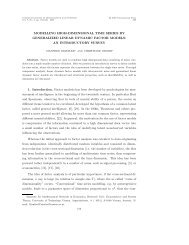Hyper-Lagrangian Submanifolds of Hyperkähler Manifolds and ...
Hyper-Lagrangian Submanifolds of Hyperkähler Manifolds and ...
Hyper-Lagrangian Submanifolds of Hyperkähler Manifolds and ...
You also want an ePaper? Increase the reach of your titles
YUMPU automatically turns print PDFs into web optimized ePapers that Google loves.
358 Naichung Conan Leung <strong>and</strong> Tom Y. H. Wan<br />
in the canonical identification between 2-forms <strong>and</strong> 2-vectors.<br />
Now we can state the following.<br />
Theorem 4.1. Let L 2n be a hyper-<strong>Lagrangian</strong> in a hyperkähler manifold M 4n with defining<br />
map J . Let K : L → S 2 be any smooth map orthogonal to J at every point <strong>of</strong> L. Then for<br />
any fixed point p ∈ L, the coefficient 1-forms <strong>of</strong> the structural equations for the canonical frame<br />
adapted to (J, K) around p satisfy the following conditions at the point p:<br />
A µν + A µν = 0 , (4.3)<br />
B νµ = 0, (4.4)<br />
C νµ = C µν , (4.5)<br />
D νµ = 1 2 δ νµ (da 3 + ida 2 ) , (4.6)<br />
E µν + E νµ = 0 , (4.7)<br />
F νµ = 0 , (4.8)<br />
E νµ = A νµ + iδ νµ db 3 , (4.9)<br />
where a α <strong>and</strong> b α are, respectively, the components <strong>of</strong> J <strong>and</strong> K with respect to the canonical basis<br />
adapted to (J, K) at p.<br />
Moreover, the differential <strong>of</strong> J at p as a map into S 2 is given by<br />
dJ p = 2 ( ImD νν J 2 + ReD νν J 3 ) for any ν = 1,... ,n.<br />
Pro<strong>of</strong>. We note that (4.3) <strong>and</strong> (4.7) are just (4.2). To prove the other conditions, we differentiate<br />
Je ν ′ = ie′ ν to obtain<br />
(∇J)e ν ′ + J ( ∇e ν<br />
′ )<br />
= i∇e<br />
′<br />
ν<br />
for all ν = 1,... ,n. Let J α be the canonical basis adapted to (J, K) at p, <strong>and</strong> a α , b α be the<br />
coefficients <strong>of</strong> J = ∑ α a αJ α <strong>and</strong> K = ∑ α b αJ α , respectively. Then by the hyper-<strong>Lagrangian</strong><br />
condition, ∇J at the point p is a linear combination <strong>of</strong> J 2 = K(p) <strong>and</strong> J 3 . Therefore, we have<br />
the following.<br />
∇J = da 2 J 2 + da 3 J 3<br />
at the point p. Putting this <strong>and</strong> the structural equations in the above equation, we obtain at the<br />
point p,<br />
(da 2 − ida 3 )f ν ′′ = 2iB νµe µ ′′ − 2iD νµf µ ′′ ,<br />
which implies the Equations (4.6) <strong>and</strong> (4.4).<br />
Similarly, applying the same argument to Jf ν ′ = if ν ′ <strong>and</strong> Ke′′ ν = f ν ′ , we obtain (4.6) again<br />
<strong>and</strong> all other Equations (4.8), (4.5), (4.9) together with the identity da 2 + db 1 = 0atp. The last<br />
identity is automatically satisfied by the definition <strong>of</strong> a α <strong>and</strong> b α .<br />
The final part is an obvious conclusion <strong>of</strong> (4.6) <strong>and</strong> the pro<strong>of</strong> is completed.<br />
The theorem indicates that hyper-<strong>Lagrangian</strong> is a strong condition which imposes a lot <strong>of</strong><br />
restrictions on the structural equations. As a consequence, we have the following.<br />
Corollary 4.2. Let L 2n be a hyper-<strong>Lagrangian</strong> in a hyperkähler manifold M 4n <strong>and</strong> for any<br />
p ∈ L, J(p)be the almost complex structure at p such that J (p)| Tp L = 0. Then J induces an<br />
integrable Kähler structure on L with holomorphic normal bundle.


